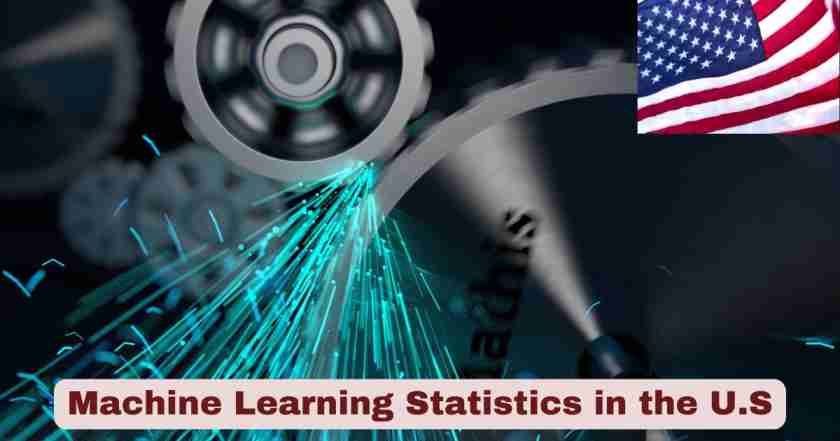Machine Learning in the U.S 2025
The United States has positioned itself as the global leader in machine learning and artificial intelligence, with 2025 marking a transformative year for widespread adoption across industries. The machine learning market is estimated to grow by 36.08% between 2024 and 2030, with the US commanding the largest market share globally. This unprecedented growth represents the most significant technological revolution since the advent of the internet, fundamentally reshaping how businesses operate and deliver value.
The North America machine learning market size is calculated at USD 21.56 billion in 2024, with projections showing exponential growth through the decade. Federal initiatives, corporate investments, and educational programs have created a robust ecosystem that supports machine learning innovation at every level. The convergence of advanced computing infrastructure, skilled workforce development, and regulatory frameworks has positioned America to capture 14.5% of global economic gains from AI adoption by 2030.
Key Machine Learning Stats & Facts in the US 2025
| Machine Learning Metric | 2025 Data | Growth Rate |
|---|---|---|
| Global ML Market Value | $113.10 billion | 36.08% CAGR |
| US ML Market Size | $21.56 billion | Leading globally |
| Business ML Adoption | 48% globally | 34% in US |
| Enterprise AI Usage | 78% of organizations | Up from 55% |
| Leading Business Investment | 92% of top companies | Consistent growth |
| Revenue Impact | 80% report increases | Significant ROI |
| Consumer Experience Focus | 57% of companies | Primary use case |
| Manufacturing Market Share | 18.88% | Largest sector |
| Finance Sector Share | 15.42% | Second largest |
| Daily AI Voice Usage | 56.4% mobile users | Growing adoption |
The machine learning market worldwide is estimated to be valued at $79.29 billion. The market is anticipated to grow at a CAGR of 36.08% between 2024 and 2030, resulting in a market volume of $503.40 billion by 2030. The United States maintains its position as the dominant force in this expansion, with American companies leading innovation across all major ML segments. This growth trajectory reflects the maturation of machine learning technologies from experimental tools to mission-critical business infrastructure.
North America (80%) leads in ML adoption, and it is followed by Asia (37%) and Europe (29%), demonstrating the substantial competitive advantage that US organizations have established. The convergence of venture capital investment, research excellence, and regulatory support has created an environment where machine learning startups and established enterprises can thrive. This ecosystem advantage translates directly into market leadership and economic benefits that extend across multiple industries and sectors.
Machine Learning Investment Landscape in the US 2025
| Investment Category | Funding Amount | Leading Companies |
|---|---|---|
| OpenAI | $11.3 billion | Most funded ML platform |
| Scale AI | $602.6 million | Second highest funding |
| Adept | $415 million | Third position |
| Cohere.ai | $414.9 million | Fourth largest |
| Anyscale | $259 million | Fifth position |
| Total Corporate AI Investment | $91.9 billion in 2022 | Global leadership |
| Daily ChatGPT Operating Cost | $700,000 | Operational scale |
| Annual Analytics Value | 40% from deep learning | Technique dominance |
Open AI is the most funded machine learning platform worldwide, valued at over 11 billion. Scale AI is the second most funded machine learning platform, receiving over $602 million in funding. These investment levels reflect the venture capital community’s confidence in American machine learning capabilities and the potential for transformative returns. The concentration of ML funding in US-based companies reinforces America’s position as the global innovation hub for artificial intelligence technologies.
The investment ecosystem extends beyond pure-play ML companies to include enterprise software providers, cloud infrastructure companies, and industry-specific applications. Almost 92% of the leading businesses have invested in Machine learning and AI, indicating widespread corporate commitment to ML transformation. This broad-based investment approach ensures that machine learning benefits reach every sector of the American economy, from manufacturing and finance to healthcare and retail.
Business Machine Learning Adoption in the US 2025
| Adoption Metric | Percentage | Industry Impact |
|---|---|---|
| Overall Business Adoption | 48% globally | Widespread implementation |
| US Corporate Adoption | 34% active, 42% exploring | Strong growth pipeline |
| Enterprise Organizations | 42% active deployment | Large-scale adoption |
| Advanced ML Users | 15% of organizations | Sophisticated applications |
| Multiple Area Deployment | 46% of companies | Comprehensive integration |
| Revenue Improvement | 80% report increases | Proven business value |
| Productivity Enhancement | 73% expect improvement | Operational efficiency |
| Competitive Advantage | 85% executive belief | Strategic differentiation |
In the latest survey, 78 percent of respondents say their organizations use AI in at least one business function, up from 72 percent in early 2024 and 55 percent a year earlier. This rapid acceleration in AI adoption reflects the increasing maturity of machine learning solutions and their proven ability to deliver measurable business outcomes. American companies are particularly aggressive in their ML deployment strategies, recognizing the competitive advantages that early adoption provides.
80% of the people reported that using machine learning rarely decreases the business’s expenses, but it definitely increases the revenue. This finding highlights a crucial insight about ML implementation: while cost reduction may not be the primary benefit, revenue enhancement through improved customer experiences, better decision-making, and new product capabilities drives substantial business value. US businesses have embraced this revenue-focused approach to ML adoption, leading to sustainable competitive advantages in global markets.
Machine Learning Industry Applications in the US 2025
| Industry Sector | Market Share | Key Applications |
|---|---|---|
| Manufacturing | 18.88% | Predictive maintenance, quality control |
| Finance | 15.42% | Fraud detection, algorithmic trading |
| Healthcare | 12.23% | Diagnosis assistance, drug discovery |
| Transportation | 10.63% | Autonomous vehicles, logistics |
| Security | 10.10% | Threat detection, cybersecurity |
| Business Services | 9.86% | Process automation, analytics |
| Energy | 5.58% | Grid optimization, demand forecasting |
| Media & Entertainment | 5.19% | Content recommendation, production |
| Retail | 4.67% | Personalization, inventory management |
| Semiconductor | 1.61% | Design optimization, testing |
The Manufacturing Industry holds the largest share of the Machine learning market. The Industry owns 18.88% of the share. The second largest market in the machine learning industry is the finance industry, with a market share of 15.42%. The manufacturing sector’s dominance reflects the industrial transformation occurring across American factories, where ML-powered systems optimize production processes, predict equipment failures, and enhance quality control.
The financial services sector leverages machine learning for sophisticated applications including algorithmic trading, risk assessment, and fraud prevention. Machine learning can predict the highs and lows of the stock market with 62% accuracy, demonstrating the practical value that ML algorithms deliver in high-stakes financial environments. American financial institutions have invested heavily in ML infrastructure, creating competitive advantages in trading, lending, and customer service.
Machine Learning Use Cases and Applications in the US 2025
| Primary Use Case | Adoption Rate | Business Impact |
|---|---|---|
| Improving Consumer Experience | 57% | Customer satisfaction enhancement |
| Generating Consumer Insights | 50% | Data-driven decision making |
| Customer Interaction | 48% | Automated service delivery |
| Fraud Detection | 46% | Security and risk management |
| Long-term Engagement | 44% | Customer retention strategies |
| Increasing Customer Loyalty | 40% | Relationship management |
| Acquiring New Consumers | 34% | Growth and expansion |
| Building Brand Awareness | 31% | Marketing effectiveness |
| Consumer Retention | 31% | Churn prevention |
| Recommender Systems | 27% | Personalization engines |
57% of the companies use machine learning to improve consumer experience. 50% of businesses use ML and AI to generate customer insights and intelligence. The focus on customer experience reflects the customer-centric approach that American businesses have adopted in their ML strategies. By prioritizing customer satisfaction and engagement, US companies create sustainable competitive advantages that translate into long-term business success.
45% of consumers prefer chatbots as the primary mode of communication, highlighting the consumer acceptance of ML-powered interfaces. This user adoption creates opportunities for businesses to reduce operational costs while improving service quality. American companies have been early adopters of conversational AI, creating sophisticated chatbot systems that handle complex customer inquiries and transactions.
Machine Learning Workforce Development in the US 2025
| Workforce Metric | Percentage | Strategic Importance |
|---|---|---|
| Companies Needing ML Skills | 82% | Critical talent requirement |
| Retraining Existing Employees | 68% | Internal capability building |
| Recruiting Skilled Talent | 58% | External acquisition strategy |
| University Recruitment | 49% | Pipeline development |
| Problem-solving Skills Priority | 37% in Europe | Soft skills importance |
| Skills Gap Impact | 23% of applicants | Recruitment challenges |
| Job Replacement by AI | 16% by 2025 | Workforce transformation |
| Jobs Affected by 2030 | 2.4 million replaced | Economic restructuring |
82% of companies and businesses need employees with machine learning skills. Machine learning skills have become a basic necessity when applying for a job. The demand for ML expertise has created a competitive talent market where companies invest heavily in workforce development. This skills premium drives higher salaries and career opportunities for professionals with machine learning capabilities.
By 2025, 16% of American jobs will be replaced by AI. AI is estimated to replace 2.4 million jobs and alter an additional 12 million occupations by 2030. While job displacement presents challenges, the net effect includes job creation in higher-value roles that require human-AI collaboration. American educational institutions and corporations are investing in reschilling programs to help workers transition to AI-augmented roles.
Machine Learning Technology Platforms in the US 2025
| ML Technology | Market Share | Application Focus |
|---|---|---|
| Newsle | 88.71% | Dominant platform |
| TensorFlow | 3.38% | Google’s framework |
| Torch | 2.75% | PyTorch ecosystem |
| Other Platforms | 5.16% | Specialized solutions |
| Voice Assistant Usage | 56.4% mobile users | Consumer applications |
| Daily Voice Search | 50% of adults | Search behavior |
| Speech Recognition Accuracy | >95% | Technical performance |
| Translation Error Reduction | 60% improvement | Language processing |
Newsle led the global Machine learning industry with the highest market share of technologies. It owned 88.71% of the share of machine learning technologies worldwide. The platform concentration reflects the network effects and ecosystem advantages that dominant ML platforms create. American technology companies have established leadership positions in platform development, creating competitive moats through comprehensive toolchains and developer communities.
56.4% of mobile users use AI-powered voice assistants, demonstrating the mainstream adoption of ML-powered interfaces. The voice technology market represents a significant opportunity for American companies to extend their platform advantages into consumer applications. Advances in speech recognition and natural language processing have made voice interfaces increasingly reliable and user-friendly.
Machine Learning Healthcare Applications in the US 2025
| Healthcare Application | Performance Metric | Clinical Impact |
|---|---|---|
| COVID-19 Prediction | 95% accuracy | Early intervention |
| Mortality Prediction | 92% accuracy | Risk assessment |
| Drug Discovery Cost Reduction | 70% savings | Pharmaceutical efficiency |
| Lung Cancer Detection | Outperforms radiologists | Diagnostic accuracy |
| Elderly Care Automation | 75% target (Japan) | Healthcare delivery |
| Death Prediction | 20 days advance | Palliative care planning |
| Physiological Deterioration | 95% accuracy | Patient monitoring |
ML can help achieve up to 95% accuracy in predicting COVID-19-related physiological deterioration. It also can predict deaths 20 days in advance with the help of an ML-based solution. These clinical applications demonstrate the life-saving potential of machine learning in healthcare settings. American healthcare systems are investing heavily in ML infrastructure to improve patient outcomes while reducing costs.
70% of drug discovery costs can be cut with the application of AI and ML. This cost reduction potential has attracted significant investment from pharmaceutical companies and biotech startups. The drug discovery process, traditionally requiring decades and billions of dollars, can be dramatically accelerated through ML-powered approaches to molecular design and clinical trial optimization.
Machine Learning Market Challenges in the US 2025
| Challenge Category | Impact Level | Mitigation Strategies |
|---|---|---|
| Scaling Difficulties | 43% of businesses | Infrastructure investment |
| Model Versioning | 41% of companies | MLOps adoption |
| Organizational Alignment | 34% face challenges | Leadership engagement |
| Data Privacy Concerns | 53% check implications | Compliance frameworks |
| Skills Shortage | Industry-wide impact | Training programs |
| Senior Buy-in | Leadership challenge | ROI demonstration |
| Reproducibility Issues | Technical complexity | Standardization efforts |
43% of businesses face challenges in scaling up when adopting AI and machine learning. Algorithmia survey further stated that 41% of companies face issues in versioning and reproducing machine learning models. These operational challenges highlight the complexity of enterprise ML deployment. American companies are investing in MLOps platforms and specialized talent to address these scaling challenges.
Only half of the companies with extensive experience in machine learning check for data privacy implications. This privacy gap represents a significant risk in an era of increasing regulatory scrutiny. US organizations are implementing comprehensive data governance frameworks to ensure ML systems comply with privacy regulations while maintaining business effectiveness.
Machine Learning Economic Impact in the US 2025
| Economic Indicator | Projected Impact | Regional Distribution |
|---|---|---|
| Global GDP Increase | 14% by 2030 | AI-driven growth |
| North America Growth | 14.5% | Regional leadership |
| China Growth | 26.1% | Competitive pressure |
| Europe Growth | 9.9-11.5% | Moderate adoption |
| Revenue Increases | 45% of economic gains | Product enhancement |
| Budget Increases | 25% for ML projects | Investment acceleration |
| Productivity Improvement | 54% potential | Operational efficiency |
45% of the royal economic gains by 2030 will be due to Machine learning and AI. AI-driven product enhancements stimulate consumer demand, and businesses and companies widely use AI products. The economic impact of ML adoption extends far beyond individual companies to reshape entire industries and national economies. American leadership in ML development positions the US economy to capture disproportionate benefits from this technological transformation.
Machine learning and artificial intelligence industry advancements are expected to increase the GDP by 14%. The budgets for machine learning projects are expected to increase by 25%. This substantial economic impact reflects the transformative potential of ML technologies across multiple sectors. US policymakers and business leaders recognize ML investment as critical infrastructure for long-term economic competitiveness.
Top 10 AI Companies Revenue in the US 2025
| Company Name | Estimated Revenue | Primary AI Focus |
|---|---|---|
| Microsoft | $245+ billion | Azure AI, Copilot, OpenAI partnership |
| Google (Alphabet) | $307+ billion | Search AI, Cloud AI, Bard/Gemini |
| Amazon | $574+ billion | AWS AI services, Alexa, logistics AI |
| Meta (Facebook) | $134+ billion | Social media AI, metaverse, advertising |
| Apple | $383+ billion | Siri, machine learning chips, privacy AI |
| NVIDIA | $79+ billion | AI chips, data center solutions |
| IBM | $62+ billion | Watson AI, enterprise solutions |
| OpenAI | $3.4+ billion (valuation) | ChatGPT, GPT models, API services |
| Salesforce | $34+ billion | Einstein AI, CRM automation |
| Adobe | $20+ billion | Creative AI, document intelligence |
The top AI companies in the United States represent a diverse ecosystem spanning cloud infrastructure, consumer applications, and enterprise solutions. These industry leaders have invested billions of dollars in AI research and development, creating comprehensive AI platforms that serve millions of users globally. Microsoft’s partnership with OpenAI has positioned the company as a dominant force in generative AI, while Google’s extensive AI research continues to drive innovation across multiple domains.
Revenue figures for AI companies reflect their total business operations, as most companies integrate AI capabilities across multiple product lines rather than operating as pure-play AI vendors. NVIDIA’s meteoric rise to $79+ billion in revenue demonstrates the critical importance of AI infrastructure, while newer companies like OpenAI achieve multi-billion dollar valuations based on their revolutionary AI technologies. The concentration of AI revenue among established tech giants highlights the substantial resources required for AI leadership.
AI Companies Distribution by State in the US 2025
| State | Number of Top AI Companies | Key Cities |
|---|---|---|
| California | 32 of top 50 | San Francisco, Palo Alto, Los Angeles |
| New York | 4 companies | New York City, Albany |
| Texas | 2 companies | Austin, Dallas |
| Massachusetts | 1 company | Boston, Cambridge |
| Washington | Major presence | Seattle, Redmond |
| Virginia | Government contractors | Northern Virginia, Richmond |
| Illinois | Enterprise solutions | Chicago |
| Pennsylvania | Research institutions | Philadelphia, Pittsburgh |
| North Carolina | Research Triangle | Raleigh, Durham, Chapel Hill |
| Georgia | Emerging hub | Atlanta |
California is home to 32 of the top 50 AI companies, demonstrating the Golden State’s dominance in artificial intelligence innovation. San Francisco alone is home to 20 of the best-funded AI companies, making it the undisputed capital of AI development. This geographic concentration reflects the network effects of Silicon Valley, where venture capital, talent, and infrastructure create self-reinforcing advantages for AI startups and established companies.
The winning states are California (35), New York (4), Texas (2) and Massachusetts (1), highlighting the stark geographic concentration of AI innovation in the United States. None of the top 50 AI startups are in a Rust Belt state, the Midwest or the South, indicating significant regional disparities in AI ecosystem development. This concentration pattern creates both opportunities for leading states and challenges for regions seeking to participate in the AI economy. State governments are increasingly implementing AI strategies to attract companies and develop local talent to capture economic benefits from AI growth.
Disclaimer: The data research report we present here is based on information found from various sources. We are not liable for any financial loss, errors, or damages of any kind that may result from the use of the information herein. We acknowledge that though we try to report accurately, we cannot verify the absolute facts of everything that has been represented.







